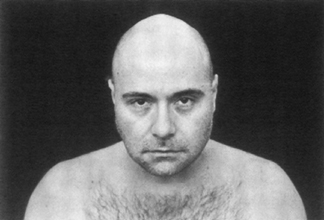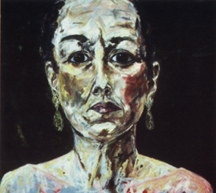Elixir for you
By Danny Tenkman

Sammy, Reluctant Painter of Palms by Peggy Blythe
Time engraves our faces with all the tears we have not shed
-Natalie Clifford Barney
Portraits have long been expected to represent the best that one can look. Coupled with flattering lighting and a variety of makeup, the intent is to capture the subject at it's most beautiful - often an aesthetic point of no return. With the exhibit Elixir, three artists bring portraits into a new realm. Their attempt is to freeze people not in their best light, but in their most human.
Many of the photographs or paintings show people trapped; confined in moments of reality ranging from weakness to aborted pride. Fatigued eyes too tired to tell their stories, faces that are worn like blue jeans.
Peggy Blythe's exhibit, titled simply The Black & White Photographs, relies on introspection.
"You are looking at the faces of 'night travelers'," Blythe writes, "the poet Rumi's name for those willing to search the darkness and their fears rather than running from them. There is something powerful about looking closely at what scares us."
Blythe uses her camera as a probe, opening the underbelly of these people's lives and walking around in them. Blythe speaks with her models as she takes the pictures. They sit placid against a black backdrop and share conversations about "dying, death, and how we choose to live." Breaking through the barriers of the awkward artist/subject relationship, Blythe captures their individual tales with her photographs.
"Facing the camera," she continues, "these people looked at more than the lens as they reflected on their own mortality."
One photograph is of a Haitian child staring long into the camera. With eyes like oil drops, he displays a look of innocence, too young to know how it hurts your feelings.
 |
|
|
"The more arresting faces recognize the enigmatic contributions of scars and lines and wear them all," Henkel says. "These faces excavate the character beneath. They will never die of ennui."
Asymmetrical, untraditional faces are on display; for Henkel, beauty does not lie in convention. Crooked noses and gaunt cheeks are examples of the perfection of human flaws.
Henkel personally knows many of her subjects and believes through exploring the contours of their faces to understand their souls.
"When I see them now," she writes, "they must feel spiritually naked because I feel as though I have stroked their soul."
Robert Morgan's The Installation is a product of the past. Many of the photographs were exhumed after 15 years of storage. Taken during Morgan's addiction to alcohol and drugs, the pieces chronicle the AIDS virus in the homosexual community. Pictures are of drag queens with pursed lips and heavy makeup with simple captions: Bradley and Bob, Darrell and Chris.
Morgan found these photographs covered in dust and felt compelled to tell their story. The story of AIDS affecting, and eventually destroying, parts of their identity.
"I watched the devastation of the AIDS epidemic and the annihilation of my whole community and family," Morgan writes in the preface to his exhibit. "That family was a small world of artists that I grew up with. They were my inspiration and part of a world now gone."
The Elixir collection draws on the expressions of the models, not the photographers. The art is in allowing for their guard to be torn down and stare starkly into the viewers' eyes. Looks, lines, gazes, scars that speak the words that tight lips conceal. Elixir may not consist of portraits we're comfortable seeing, but that's exactly what the artists intended.
Elixir opens Monday, Oct. 22 at Morlan Gallery. Call for more info. 233-8210